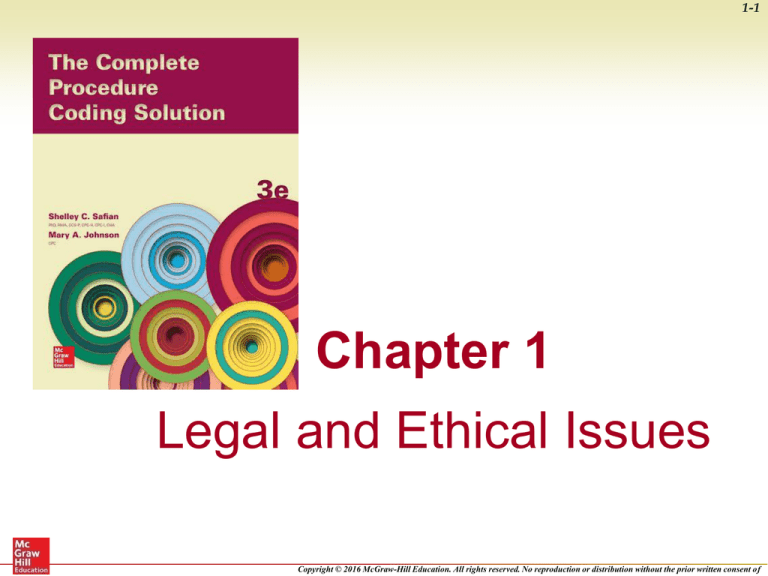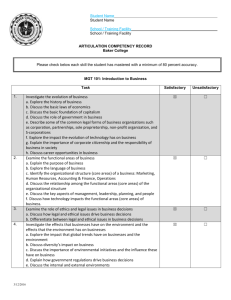
1-1
Chapter 1
Legal and Ethical Issues
Copyright © 2016 McGraw-Hill Education. All rights reserved. No reproduction or distribution without the prior written consent of
1-2
Learning Objectives
1.1 Identify your responsibilities under
HIPAA’s Privacy Rule to protect a patient’s
information.
1.2 Elaborate on the purpose of the Health
Care Fraud and Abuse Control Program.
1.3 Analyze the use of the National Correct
Coding Initiative.
Copyright © 2016 McGraw-Hill Education. All rights reserved. No reproduction or distribution without the prior written
1-3
Learning Objectives (cont.)
1.4 Apply the rules of ethical and legal
coding.
1.5 Identify the points within industry
codes of ethics that will direct your
conduct as a professional coder.
1.6 Outline the purpose of a compliance
program.
Copyright © 2016 McGraw-Hill Education. All rights reserved. No reproduction or distribution without the prior written
1-4
Key Terms
• Code for coverage
• Covered entities
• Disclosure
• Ethical behaviors
• Fraud
• HIPAA’s Privacy Rule
Copyright © 2016 McGraw-Hill Education. All rights reserved. No reproduction or distribution without the prior written
1-5
Key Terms (cont.)
• Mutually exclusive codes
• Protected health information (PHI)
• Supporting documentation
• Unbundling
• Upcoding
• Use
• Willful ignorance
Copyright © 2016 McGraw-Hill Education. All rights reserved. No reproduction or distribution without the prior written
1-6
Health Insurance Portability and
Accountability Act (HIPAA)
• The Privacy Rule
– protects an individual’s privacy, specifically a
patient’s personal information.
– allows patients’ information to be easily
accessible to authorized parties (physicians,
coders, billers, etc.).
– secures patients’ personal information from
unauthorized parties (potential employers,
co-workers, etc.).
Copyright © 2016 McGraw-Hill Education. All rights reserved. No reproduction or distribution without the prior written
Who Is Responsible for Obeying
This Law?
• Covered entities are divided into three
categories
– Healthcare providers
• Physicians, hospitals, laboratories, pharmacies, etc.
– Health plans
• Medicaid, Medicare, Blue Cross Blue Shield,
Tricare, etc.
– Healthcare clearinghouses
• National Clearinghouse, NDC Electronic Claims
Copyright © 2016 McGraw-Hill Education. All rights reserved. No reproduction or distribution without the prior written
1-8
Who Is Responsible for Obeying
This Law? (cont.)
• Covered entities include every member of
the workforce regardless of job title:
– Full time employees
– Part-time employees
– Interns/externs
– Volunteers
– Physicians
– Nurses
– Assistants
Copyright © 2016 McGraw-Hill Education. All rights reserved. No reproduction or distribution without the prior written
1-9
What This Law Covers
• Extension of doctor-patient confidentiality.
• Access to personal and confidential
information (essential to accurately
reporting data).
• Protected health information (PHI).
• Any individually identifiable health
information regardless of form.
Copyright © 2016 McGraw-Hill Education. All rights reserved. No reproduction or distribution without the prior written
1-10
The Use and Disclosure of PHI
• USE
– Information is shared between people who
work together in the same office and need to
exchange PHI in order to better serve the
patient.
• DISCLOSURE
– PHI is revealed to someone outside the
healthcare office or facility in order to better
serve the patient.
Copyright © 2016 McGraw-Hill Education. All rights reserved. No reproduction or distribution without the prior written
1-11
Getting Written Approval
• Documentation must be written in plain
language (not legalese) so that the
average person can understand what he
or she is signing.
• Documentation must specify exactly what
information will be disclosed or used.
Copyright © 2016 McGraw-Hill Education. All rights reserved. No reproduction or distribution without the prior written
1-12
Getting Written Approval (cont.)
• Documentation must specifically identify
the person or organization that will be
disclosing the information.
• Documentation must specifically identify
the person(s) who will be receiving the
information.
Copyright © 2016 McGraw-Hill Education. All rights reserved. No reproduction or distribution without the prior written
1-13
Getting Written Approval (cont.)
• Documentation must have a definite
expiration date.
• Documentation must clearly explain that
the person signing the release may
retract the authorization in writing at any
time.
Copyright © 2016 McGraw-Hill Education. All rights reserved. No reproduction or distribution without the prior written
1-14
Permitted Uses and Disclosures
Circumstances under which healthcare
professionals are permitted to use their
best professional judgment to use and/or
disclose a patient’s PHI (with or without
written patient permission) …
Copyright © 2016 McGraw-Hill Education. All rights reserved. No reproduction or distribution without the prior written
1-15
Permitted Uses and Disclosures
(cont.)
1. To the individual
2. For treatment, payment, and/or operations
(TPO)
3. Opportunity to agree or object
4. Incidental use and disclosure
5. Public interest
6. Limited data sets
Copyright © 2016 McGraw-Hill Education. All rights reserved. No reproduction or distribution without the prior written
1-16
Privacy Notices
• Notices of Privacy written in compliance
with HIPAA’s Privacy Rule must contain:
– A full description of how the covered entity
may use and/or disclose a patient’s PHI.
– A statement about the covered entity’s
responsibility to protect a patient’s privacy.
Copyright © 2016 McGraw-Hill Education. All rights reserved. No reproduction or distribution without the prior written
1-17
Privacy Notices (cont.)
…as well as…
– Complete information about the patient’s
rights.
– The name of a specific employee of the
covered entity must be named as privacy
officer.
Copyright © 2016 McGraw-Hill Education. All rights reserved. No reproduction or distribution without the prior written
1-18
Violating HIPAA’s Privacy Rule
• Civil Penalties
– $100 for each single violation.
– Maximum of $25,000 for multiple violations.
Copyright © 2016 McGraw-Hill Education. All rights reserved. No reproduction or distribution without the prior written
1-19
Violating HIPAA’s Privacy Rule (cont.)
• Criminal Penalties
– Up to $50,000 and up to 1 year in jail for the
unauthorized or inappropriate disclosure of
individually identifiable health information.
– Up to $100,000 and up to 5 years in prison for
the unauthorized or inappropriate disclosure
of individually identifiable health information
through deception.
Copyright © 2016 McGraw-Hill Education. All rights reserved. No reproduction or distribution without the prior written
1-20
Violating HIPAA’s Privacy Rule (cont.)
• Criminal Penalties
– Up to $250,000 and up to 10 years in prison
for the unauthorized or inappropriate
disclosure of individually identifiable health
information through deception with intent to
sell or use for business-related benefit,
personal gain, or hateful detriment.
Copyright © 2016 McGraw-Hill Education. All rights reserved. No reproduction or distribution without the prior written
1-21
Health Care Fraud
• Health Care Fraud and Abuse Control
Program
– Created by HIPAA.
– Investigates attempts of fraud and abuse in
the healthcare system (including Medicaid
and Medicare).
– Acts in association with the Office of the
Inspector General (OIG) and coordinates with
federal, state, and local law enforcement
agencies.
Copyright © 2016 McGraw-Hill Education. All rights reserved. No reproduction or distribution without the prior written
1-22
National Correct Coding Initiative/
Federal False Claims Act
• National Correct Coding Initiative
(NCCI) was created by Centers for
Medicare and Medicaid Services (CMS).
• Updated annually by CMS.
• Documentation is crucial.
Copyright © 2016 McGraw-Hill Education. All rights reserved. No reproduction or distribution without the prior written
1-23
National Correct Coding Initiative/
Federal False Claims Act (cont.)
• Federal False Claims Act forbids the
submission of healthcare claims with the
intention of gaining financial consideration
by stating details that are not true and
accurate.
Copyright © 2016 McGraw-Hill Education. All rights reserved. No reproduction or distribution without the prior written
1-24
Rules for Ethical & Legal Coding
• Codes on the health claim form must
represent the services actually performed
and are supported by notes and other
documentation in the patient’s health
record.
– Don’t use a code on a claim form without
having supporting documentation in the file.
Copyright © 2016 McGraw-Hill Education. All rights reserved. No reproduction or distribution without the prior written
1-25
Rules for Ethical & Legal Coding
(cont.)
• Coding for coverage (coding services
based on what insurance companies will
pay for, or “cover,” not for true services
rendered) is not permitted.
• All codes must reflect services and
procedures rendered.
Copyright © 2016 McGraw-Hill Education. All rights reserved. No reproduction or distribution without the prior written
1-26
Rules for Ethical & Legal Coding
(cont.)
• Upcoding, an illegal process, is considered
falsifying records.
• Resubmitting a claim that has been lost must
be identified as a “tracer” or “second
submission”.
• Unbundling is not permitted.
• All services provided during one encounter
must be placed on one claim form.
Copyright © 2016 McGraw-Hill Education. All rights reserved. No reproduction or distribution without the prior written
1-27
Codes of Ethics
• Two premier trade organizations for
professional coding specialists have
codes of ethics:
– American Health Information Management
Association Code of Ethics (AHIMA).
– American Academy of Professional Coders
(AAPC).
Copyright © 2016 McGraw-Hill Education. All rights reserved. No reproduction or distribution without the prior written
1-28
Codes of Ethics (cont.)
• AHIMA Code of Ethics
– Ensure confidentiality
– Honor patients, peers, and selves
– Protect PHI
– Avoid unethical practices
– Promote knowledge
– Perform honorably
Copyright © 2016 McGraw-Hill Education. All rights reserved. No reproduction or distribution without the prior written
1-29
Codes of Ethics (cont.)
• AHIMA Standards of Ethical Coding
– Support accurate coding practices
– Follow official guidelines
– Code only what is documented
– Query physicians for clarification
– Advocate proper credentialing
– Continue education
Copyright © 2016 McGraw-Hill Education. All rights reserved. No reproduction or distribution without the prior written
1-30
Codes of Ethics (cont.)
• AAPC Code of Ethical Standards
– Maintain highest standard of conduct
– Use only legal and ethical means
– Pursue excellence through continuing
education
– Do not exploit relationships for personal
gain
Copyright © 2016 McGraw-Hill Education. All rights reserved. No reproduction or distribution without the prior written
1-31
Compliance Programs
• Compliance programs
– Create policies and procedures
– Establish the structure to adhere to those
policies
– Set up a monitoring system to ensure
compliance
– Correct conduct that does not comply
Copyright © 2016 McGraw-Hill Education. All rights reserved. No reproduction or distribution without the prior written
1-32
Compliance Programs (cont.)
• The Seven Steps to Due Diligence
1. Establish compliance standards and
procedures.
2. Assign overall responsibility to specific
high-level individuals.
3. Attempt to avoid delegation of authority to
individuals that may result in illegal actions.
Copyright © 2016 McGraw-Hill Education. All rights reserved. No reproduction or distribution without the prior written
1-33
Compliance Programs (cont.)
• The Seven Steps to Due Diligence
4. Effectively communicate standards and
procedures to all staff.
5. Utilize monitoring and auditing system for
compliance.
6. Enforce adequate disciplinary sanctions
when appropriate.
7. Respond to episodes of non-compliance by
modifying program.
Copyright © 2016 McGraw-Hill Education. All rights reserved. No reproduction or distribution without the prior written
1-34
Chapter Summary
• Know your legal and ethical
responsibilities.
• Confidentiality, honesty, and accuracy
are three watchwords that all health
information management professionals
should live by.
Copyright © 2016 McGraw-Hill Education. All rights reserved. No reproduction or distribution without the prior written






